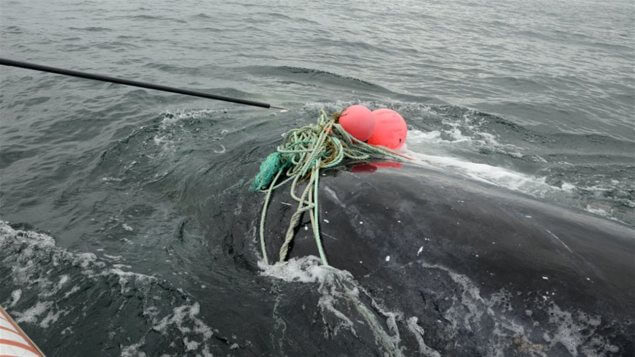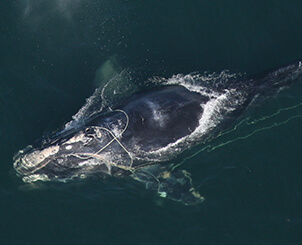As evidenced by the news in the past few weeks, when whales get entangled in fishing gear, there can be serious consequences for the whales themselves, as well as for those who attempt to free them. The Whales Online team takes another look at the events of the past few weeks and tries to answer these big questions: Why protect these giants of the seas from entanglements? And how?
Recap of events and measures implemented
Since June 6, four entangled right whales and eight dead right whales have been spotted in the Gulf of St. Lawrence. One of the carcasses analyzed by researchers – a 13.3 m female – had traces of chronic entanglement; in other words, she had been dragging the fishing ropes around for quite some time. Analyzing the rope will make it possible to narrow down the time of entanglement.
On July 10, during an operation to free a right whale off Shippagan, New Brunswick, Joe Howlett of the Campobello Whale Rescue Team lost his life. As a result of this tragic event, both the Department of Fisheries and Oceans Canada (DFO) and the National Oceanic and Atmospheric Administration (NOAA) suspended their disentanglement program for an undetermined period to review their procedures. No intervention was therefore considered to release the entangled right whale observed in Canadian waters on July 20.
Since July 14, DFO has also attempted to minimize risks of entanglement by temporarily closing all snow crab fishing activity in a part of the Gulf of St. Lawrence where a concentration of right whales was observed.
Deadly entanglements
In many coastal regions, bycatch in fishing gear is one of the main causes of cetacean mortality. According to the International Whaling Commission, bycatch is responsible for the deaths of more than 300,000 cetaceans every year throughout the world.
In certain cases, the problem is so serious that it endangers entire populations. Examples include the Gulf of California porpoise (vaquita), which might become extinct within a year due to bycatch, and the North Atlantic right whale, an endangered population in which 85% of mortalities in 2015 were attributed to incidental catches.
When entanglement does not cause death…
Entanglement that does not kill an animal can have long-term consequences on its health and reproduction, as evidenced by recent studies on the North Atlantic right whale. A study published last March demonstrates that severe entanglement can lead – in as little as 16 days – to a deteriorating health status in a right whale, particularly in individuals with high energy requirements, such as young individuals and lactating females. Entanglement can make feeding or swimming more difficult or less effective, which increases the risk that the whale will enter a state of energy deficit which, when prolonged, may limit the chances of the individual’s recovery. And when a female is in sub-optimal physical condition, her chances of breeding are lower, reveals another study published last year. Might the decline in calving since 2010 be partly due to entanglement and the ensuing deteriorated physical fitness? This is what researchers are suggesting. When one considers that 83% of right whales have been entangled at least once in their lives – as evidenced by the scars on their bodies and the ropes they drag with them – and that 15.5% of the population gets entangled every year, incidental catches can have serious consequences on the recovery of this population.
In the St. Lawrence
In the St. Lawrence, cetaceans are observed annually – most often minke whales, humpback whales and fin whales, but sometimes also belugas, harbour porpoises, dolphins, sperm whales and pilot whales – ensnared In nets or ropes. The fishing gear that causes the most entanglements, according to the incidents recorded in the St. Lawrence, are traps, cages and gillnets.
Over the past 10 years, the Quebec Marine Mammal Emergency Response Network (QMMERN) has identified 78 cases in the Gulf of St. Lawrence and its Estuary of incidental catches of marine mammals, including live entangled animals as well as dead or living animals showing signs of entanglement. However, given that not all cases are reported to QMMERN and that it is estimated that many entangled animals do not wash ashore but rather disappear at sea, it is impossible to estimate the exact number of incidental catches in the region.
As for entanglements of right whales, the phenomenon seems to be new in the St. Lawrence. “Four entangled right whales observed in the Gulf of St. Lawrence in a single season is unprecedented,” mentions Josiane Cabana, director of the QMMERN call centre.
In recent years, increasing numbers of right whales have been observed in the Gulf of St. Lawrence. Might this explain the unusual number of entanglements? What measures will have to be implemented in the St. Lawrence to prevent such incidents from recurring?
How can we protect whales from entanglements?
Many measures have recently been put in place to reduce the risk of entanglement, including the development of ropes that are less resistant and therefore safer for whales, a new US regulation on seafood imports – according to which foreign fisheries wishing to export to the United States would have to protect marine mammals to standards similar to those governing US fisheries – and more recently in the Gulf of St. Lawrence, the closure of a fishing zone. In a study released this month in Marine Policy, researchers suggest closing two other fishing grounds in Canada – the Grand Manan Basin and the Roseway Basin – during the summer season to protect the right whale.
Closing fishing grounds could prove to be an effective measure. However, given that the right whale’s feeding grounds appear to be changing, and that the distribution of other cetacean species is likely to shift with climate change, it will be essential to monitor populations and prey to properly identify and regularly update the areas to be closed to commercial fishing.
Sources
- Banville, Y. 2010. Identification d’innovations en vue de limiter les prises accessoires de mammifères marins. Pêches et Océans Canada.
- Body condition changes arising from natural factors and fishing gear entanglements in North Atlantic right whales Eubalaena glacialis. Endangered Species Research, doi: 10.3354/esr00800
- Brillant S.W., Wimmer T., Rangeley R.W. et C.T. Taggart. 2017. A timely opportunity to protect North Atlantic right whales in Canada. Marine Policy, doi: 10.1016/j.marpol.2017.03.030
- Cetacean bycatch and the IWC (IWC, 2004)
- Snow Crab in the Southern Gulf of St. Lawrence – Crab Fishing Area 12 (12, 18, 25, 26) – Extension of the Fishing Season (DFO, 2017-07-10)
- Rolland R.M., Schick R.S., Pettis H.M., Knowlton A.R., Hamilton P.K., Clark J.S. et Kraus S.D. 2016. Health of North Atlantic right whales Eubalaena glacialis over three decades: from individual health to demographic and population health trends. Marine Ecology Progress Series, doi: 10.3354/meps11547
- Pettis H.M., Rolland R.M., Hamilton P.K., Knowlton A.R., Burgess E.A. et Kraus S.D. 2017.
- Man dies attempting to save a whale off the coast of Shippagan (in French, Radio-Canada, 2017-07-10)







